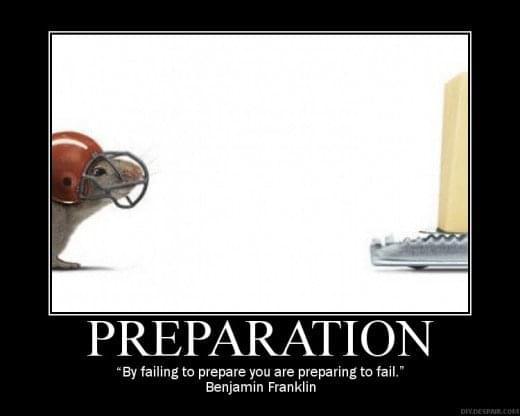
1. Preparation is Key
According to Dice.com, the career website that serves IT and engineering professionals, top tech recruiters know that treating passive candidates like active job seekers is a waste of time. They just won’t reply. So when it comes to improving your chances of getting in-demand tech pros to engage with you, the preparation for first communication is key. Talented tech pros get bombarded by recruiters. Many receive 20+ InMails and emails every week, so it’s no wonder most of these attempts to reach out are treated as spam.
 Many of the aforementioned messages are generic, with titles like, “We need a Java programming guru in Chicago. Interested?” and the attached job descriptions are boring and loaded with bullet point after bullet point of role requirements. Why would a top tech candidate, who is not actively looking for a job, even bother opening a message like that?!Personalization and customisation is the key to improving your response rates from these candidates (we’ll talk more about that later), but in order to be able to effectively personalize and customise your communication to ensure a response, you must first do your research into what makes them tick:
Many of the aforementioned messages are generic, with titles like, “We need a Java programming guru in Chicago. Interested?” and the attached job descriptions are boring and loaded with bullet point after bullet point of role requirements. Why would a top tech candidate, who is not actively looking for a job, even bother opening a message like that?!Personalization and customisation is the key to improving your response rates from these candidates (we’ll talk more about that later), but in order to be able to effectively personalize and customise your communication to ensure a response, you must first do your research into what makes them tick:
1. Research their interests and expertise
It goes without saying that, hardware engineers are different from software engineers. And within software engineering, there are several specialty areas including front end, back end, embedded systems, mobile apps, the list goes on. So, before you contact them, you must know something about the kind of technology and work that interests them. Simply knowing they’ve done Java programming a some stage is not enough.What kind of technology are they passionate about? Are they contributing code to the open source community, sharing ideas in forums, or writing blog posts that highlight their expertise? You want – no, you need – to know this ahead of time. Discovering and using this information in your first approach will help you make a more credible introduction and avoid generic approaches.
The good news is that engineers often publicly share their interests and areas of expertise on sites like GitHub, Stack Overflow, and in various forums across the web (read: Twitter) which means finding out exactly what they do and how they do it, isn’t as difficult as it first appears.
2. Research their current employer
What does their company do? Is it a tech startup, a well-established non-tech company, or a well-known global leader in technology? Use that information to help differentiate your company from the work they do now. Your smaller company might offer them a bigger job with a larger scope than they’d have as at their current company. Your company might offer them the chance to work on building something new – something that will impact millions versus the maintenance work they do now. Is their company doing well? Is it growing? Is it profitable? Are their products well received in the marketplace? Remember, Engineers don’t just care about the technology they work on. They also want to work with companies that are successful and growing – organizations that will offer them more opportunities to lead and use new and exciting technologies.
3. Research their career history
What career moves has this person made? If you can find out where else they’ve worked, you may gain insight that will help you craft a better targeted message or reply to questions or concerns. Have they been a full-time employee their entire career, working for companies for 4-5 years at a time? If so, a 6-month contract position may be a hard sell. Have they moved around the country quite a bit? Or, are they still living in the same town where they went to college 10 years ago? If so, getting them to relocate can be a much bigger barrier than quitting a job they like. Finally, does it appear that they’re working virtually for a company that doesn’t have a tech centre in their city? If so, a job that doesn’t offer the flexibility they need may be a deal-breaker.
Additionally, if you did need them to relocate, you’ll want to proactively research cost of living differences where you’d like them to move. The salaries required to maintain a good living situation in NYC versus Kansas City, for example, are quite different. You need to know this before you target someone, because you could be wasting your time and theirs if your compensation packages and relocation offerings won’t come close to addressing the significant cost differences. Having said that, some candidates might be excited to return “home.” So, if you can tell that a candidate moved away, and your opportunity is closer to where they went to college or grew up, you may be able to offer them the chance to move back to family and friends.
4. Research their connections
We all know that leveraging a shared connection to turn a cold email into a warm one is the stuff of Recruiting 101. So, it would be ridiculous not to leverage social media, your colleagues’ shared work history, and your own work history to improve your chances of getting a response and/or helping to gain additional insights about this passive candidate’s motivators and interests, wouldn’t it? So do some digging.
5. Research your own company and jobs
What’s the value proposition for a top engineer at your company? We’re not talking about the buzzwords on the job description here, we’re talking about the specific projects this candidate will work on, the impact their work would make, the team they’d work with, and the salary and relocation packages available. As we said earlier, do your research and your credibility will skyrocket.
2. Contact Them in the Right Place
 According the Stack Overflow’s research, email is the top preferred means of communication for developers, with 65% of respondents saying email is a “great” way to hear about new job opportunities.
According the Stack Overflow’s research, email is the top preferred means of communication for developers, with 65% of respondents saying email is a “great” way to hear about new job opportunities.
But be warned, 44% of developers “hate” to be contacted about job opportunities over the phone and 52% feel the same way about Facebook. And don’t even think about sending a LinkedIn InMail. 22% of developers don’t even have a LinkedIn profile, and those that do, don’t use it. So the likelihood is your InMail will go unseen and unanswered.
3. Crafting Your Message
Now that you’ve done your research and you know that email is their preferred method of contact, it’s time to construct the message that will ensure a response from your passive tech candidate. We’re not going to lie, this is the hard part. But if you follow these tips you will have the best chance of getting that coveted response. So, how do you get a passive tech pro interested? Well, do you remember what we told you about personalization and customisation earlier? A personalized approach is a pre-requisite for a successful engagement with a tech candidate, in fact 60% of developers say a personalized message would make them want to respond to message from a recruiter. So, it’s time to put all your research to good use.
1. Pique their interest
Software engineers are smart, curious people, who like to build (and break) stuff. They are naturally driven to solve challenging problems. And the best engineers see the tools and technology they use to solve interesting problems as just that – tools. Not as something that should define them, or define a job. So, if you’re describing your opportunity by sharing the buzzwords from your job description – simply highlighting the technologies you need and specialised skills you want, you will not attract top tech talent. Why? The best engineers know that technologies and tools change all the time. Getting stuck using one language or working with one type of technology can be death to their long-term marketability, and can be quite boring over time.
Use the research you conducted into the candidate’s interest and expertise and their current employer to highlight specific examples of the work – the actual projects they’d work on – that will be so interest to them in your company. Tell them what the kind of impact their work would that make on the customer, marketplace or even the world. Then, pique their interest by referencing something (maybe even something you can’t talk about now – future, cool stuff) that’s bigger than a job. Paint a picture that shows them where they can take this – maybe it’s the role they could play in building a new, disruptive, game-changing product for your industry. Maybe it’s something that’s never been done at this scale before. Or, maybe it’s just a really hard technical problem that hasn’t been solved yet. Focus on the work because 60% of developers said product details are the most important aspect of a new job.
2. Drop names and leverage specific connections
 Please don’t say, “Your name came up in a meeting we had this morning, and I’d like to talk to you about a unique opportunity.” That’s way too general, and it just sounds salesy. However, if you’ve learned through your research that you actually know someone they know, use that connection. “My name is Jim, and we both worked with Kelan back at [company]. Kellan told me a lot about you, and suggested we connect live. I read that [post/article/blog/answer] you wrote on [site]. You’ve got an impressive background in [technology/problem space]. We’re in the early phase of development, working on something in that space that’s never been built before. Kellan thought you’d be really interested in learning more. Can you talk for 10 minutes?”The key, of course, is if they say “Yes,” you have to be able to do more than read the job description to keep them interested. You must really understand the challenging work and be able to go relatively deep when the candidate starts to ask questions. Do not – under any circumstance – refer them to your careers site to learn more. They will drop you like a hot potato and you will never hear from them again, and in case you hadn’t already guessed, they won’t apply either. Do not send them a job description of any sort. It’s too early in the process for that.
Please don’t say, “Your name came up in a meeting we had this morning, and I’d like to talk to you about a unique opportunity.” That’s way too general, and it just sounds salesy. However, if you’ve learned through your research that you actually know someone they know, use that connection. “My name is Jim, and we both worked with Kelan back at [company]. Kellan told me a lot about you, and suggested we connect live. I read that [post/article/blog/answer] you wrote on [site]. You’ve got an impressive background in [technology/problem space]. We’re in the early phase of development, working on something in that space that’s never been built before. Kellan thought you’d be really interested in learning more. Can you talk for 10 minutes?”The key, of course, is if they say “Yes,” you have to be able to do more than read the job description to keep them interested. You must really understand the challenging work and be able to go relatively deep when the candidate starts to ask questions. Do not – under any circumstance – refer them to your careers site to learn more. They will drop you like a hot potato and you will never hear from them again, and in case you hadn’t already guessed, they won’t apply either. Do not send them a job description of any sort. It’s too early in the process for that.
3. Don’t ask for a resume yet
Before engaging with a candidate for the first time, you should ask yourself, “What is my objective here?” If your answer is to get that person to apply for your job or send you their resumé, you’re only setting yourself up to fail. Passive candidates – by definition – are not actively looking for a job. They likely don’t have a prepared resume, and won’t be interested in applying to your open job.
The objective of your first contact is to start a conversation. That’s it. It’s a really simple goal but essential to understand before you try and reach out to anyone.
Once you understand you objective, it’s much easier to adjust your language, tone and style to focus on a truly successful outcome – a response! Yes, your goal is simply to get a response – any response. These days, candidates are so overwhelmed with unsolicited approaches from recruiters that most simply ignore them. Getting a reply and starting a conversation should be your objective. So start thinking about what would get this candidate to reply – and not reply.
4. Pimp your ride
Before they even think about replying to your email, you’re candidate will look you up online. In 2015, that’s a simple fact of life. So you need to be sure that each and every one of your online profiles don’t suck. Ideally, you want them to read your profile and think to themselves, “This looks like a good person for me to connect with – even if the opportunity she’s calling me about isn’t right for me now. She’s clearly the kind of person who could help me in my career. I think I should email her back.”
Demonstrate your tech recruiting credibility online by:
- Showing how you’re connected to people like them (people and communities/groups)
- Having recommendations from people like them (hiring managers and candidates)
- Focusing on recruiting people like them
4. What To Do When You Get the Reply
*PING* A reply email from that coveted tech candidate has popped into your inbox. You’re hard work has paid off. But what do you do now? How do you keep their interest? Well, the first thing to remember is that your goal at this point is not to interview them. It’s still too early for that. You’re objective is now to find out even more about them and determine whether or not they will fit into your organization.
Prepare questions that will help you understand if this is a good match, but focus you language on “you, your and yours”, not “we, I or us”. For example, “Based on what I learned about you on your [blog/white paper/bio/Quora answer/Stack Overflow contribution], you clearly have expertise in XYZ. I’d like to learn a little more about what you enjoy about that kind of work, and the sort of problems you’re passionate about solving. And then I can answer some questions about the challenging work we’re doing with XYZ, to give us both an idea as to whether or not this opportunity would be something you’d like to learn more about. Sound good? Great. Can you start off by telling me a little more about the ABC project you’re working on now? I read about it online, but would like to learn more.”
Top Takeaways:
- The foundation of good engagement is research. Learn as much as you can about a candidate’s interests and motivations (not just the keywords and technologies in their profile) to ensure the kind of opportunities you have align with what they likely want. And use this information to customise your approach.
- 65% of developers say email is a “great” way to hear about new job opportunities.
- Whatever your specific approach, the most successful passive tech talent messaging seems to share a few things in common:
- The message is succinct and focused; it’s never a mass email template.
- The message is succinct and focused; it’s never a mass email template.
- The message is customised and personalised; it’s clear you’ve done your research and know something specific about them, their interests and expertise
- The messages are about them, not you; in fact, job descriptions are not usually attached at this phase
- The request is not for a resume or a request to apply online; it’s for a next-step exploratory chat
- When the candidate replies, the objective of your next exchange is to find out more about teh candidate to determine if they are a good fit for your organization. Prepare question to ask them about their work and projects they enjoy, and your questions so that the words “you, your and yours” are used frequently. Make this exchange about them.
To download the full results of Stack Overflow’s Developer Hiring Landscape survey, click here.
See the original post at: SocialTalent.co.